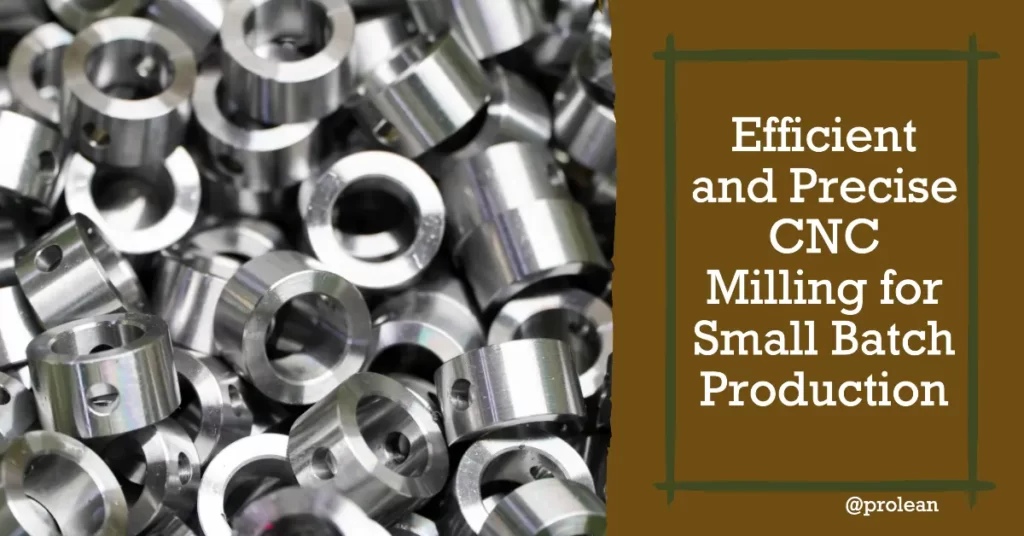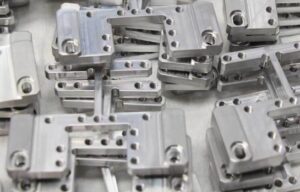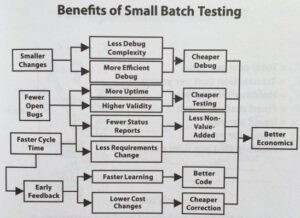“The small-batch production with CNC milling enables the creation of precise and cost-effective parts for functionality test and market review. Start-ups and small businesses can leverage this approach to take their idea into the market with limited resources. “

CNC milling for small-batch production blends cutting-edge computer numerical control (CNC) technology with flexibility intrinsic to small-batch outputs. It addresses the increasing need for specialized, custom solutions across various sectors. And it’s not just about meeting demands; it’s about achieving perfection without compromising speed or cost-efficiency. The Small-batch CNC milling ensures businesses can achieve this balance with precise operations and rapid production cycles. This article will discuss CNC milling small-batch production’s essence, advantages, and transformative impact on modern-day manufacturing.
The Rise of Small Batch Production
During the industrial revolution, mass production was the hallmark of success. Big factories made countless identical items, showcasing modern efficiency. But as we entered the 21st century, things changed. Instead of valuing sameness, people started appreciating uniqueness.
Whether custom software or personalized fashion, everyone wants something made just for them. This change brought small-batch production to the forefront. For example, the automotive OEM’s small volume production business unit has a diverse product mix and many machine set-ups for different production orders that take only 4-12 hours on average. Source
Why Small-batch Production?
Several factors have fueled the move towards smaller batch production:
- Consumer Demand for Personalization: Modern consumers crave products that resonate with their unique personalities and preferences. They seek exclusivity, something distinct from the mass-produced items that everyone else owns.
- Rapid Technological Advancements: Innovations in manufacturing technology, especially AI and machine learning integration, have made it feasible to produce small batches without significant cost escalations.
- Agile Market Responses: Small batch production allows companies to adjust to market trends quickly, ensuring they remain relevant and competitive.
- Sustainable and Ethical Manufacturing: As the world becomes more conscious of its consumption patterns, there’s a push towards sustainable and ethically produced products. Small batches often align better with these ideals, reducing wastage and ensuring ethical labor practices.
- Risk Mitigation: Launching a new product is always a gamble. Small batch production allows companies to test the waters without committing vast resources. If a product flops, the financial repercussions are minimized.
Let’s discuss some of these aspects through illustrative means:
Table: Comparing Mass Production and Small Batch Production
| Feature | Mass Production | Small Batch Production |
|---|---|---|
| Volume | High | Low |
| Customization | Limited | High |
| Market Response Time | Longer due to large-scale operations | Rapid due to flexible operations |
| Wastage | Potential for high wastage in overproduction | Minimal due to controlled production |
| Startup Costs | Typically high | Lower |
| Risk | High (large volumes) | Lower due to limited production volume |
The Process of Small Batch CNC Milling Production

CNC milling small-batch production
CNC (Computer Numerical Control) milling harnesses the power of computer programming to control machine tools, ensuring each product is crafted to exact specifications. Small-batch CNC milling is particularly beneficial for projects that require a high level of customization and precision. Let’s journey through the step-by-step process of small-batch CNC milling production, uncovering the intricacies that make it a favorite among manufacturers.
Step 1: Design and Planning
The foundational phase of any CNC milling project is design and planning. Here, the product to be manufactured is conceptualized and designed. This design is then translated into a digital format that the milling machine can understand. CAD (Computer-Aided Design) software is typically employed to create a detailed 3D model of the product.
Key Activities
-
- Conceptualizing the product.
- Creating a detailed design using CAD software.
- Translating the design into machine-readable format, typically G-code.
Step 2: Selection of Raw Materials
The essence of the end product is determined by the materials chosen. The choice of raw materials is pivotal in determining the product’s durability, appearance, and functionality. Materials ranging from metals to plastics can be chosen depending on the product specifications and requirements. The selected material is then prepared for the milling process, ensuring it’s of the right size and shape.
Key Activities
-
- Determining the most suitable material based on product specifications.
- Procuring the chosen material.
- Pre-processing the material, like cleaning and cutting, to prepare it for milling.
Step 3: Setting up the CNC Milling Machine
Each CNC machine is tailored to the specific milling task. Setting up the CNC machine is a crucial step. It involves configuring the machine according to the design specifications. This includes loading the correct tools, ensuring the machine is calibrated correctly, and inputting the G-code so the machine understands the design it needs to produce.
Key Activities
-
- Tool selection and installation.
- Machine calibration.
- Uploading the G-code.
Step 4: Actual Milling Process
The core step is where the raw material transforms into a product. With everything set up, the actual milling begins. The CNC machine, guided by the G-code, starts cutting, drilling, and shaping the raw material. Due to the precision of the CNC machine, even intricate designs can be achieved with high accuracy.
Key Activities
-
- Positioning the raw material in the machine.
- Starting the milling process.
- Monitoring the process for any discrepancies or issues.
Step 5: Quality Control and Inspection
Ensuring every product meets the desired standards. Once the milling is complete, each product undergoes rigorous quality control. This ensures that the product matches the design specifications and is free from defects. Any products that don’t meet the quality standards are reworked or discarded.
Key Activities
-
- Visual inspection for any visible defects.
- Measurement of the product to ensure it matches design specifications.
- Functional tests, if applicable.
Step 6: Post-Processing
Giving the final touches to the milled product. Depending on the product and its intended use, it might undergo post-processing. This could include activities like painting, polishing, or assembling parts together. Post-processing ensures the product is not only functional but also aesthetically pleasing.
Key Activities
-
- Sanding or polishing to achieve a smooth finish.
- Painting or coating for protection and appearance.
- Assembling multiple parts if the product is not a single piece.
Step 7: Packaging and Delivery
The final step is before the product reaches the end-user. Once the products have been milled and post-processed, they are packaged carefully to ensure they aren’t damaged during transportation. They’re then dispatched to either warehouses, retail outlets, or directly to the customer.
Key Activities
-
- Selection of appropriate packaging materials.
- Packaging the products securely.
- Dispatching the products for delivery.
Applications of Small Batch CNC Milling
The CNC milling offers versatility that other manufacturing methods often can’t match, especially in small batches. From bringing an idea to life in the form of a tangible prototype to producing bespoke pieces that cater to niche markets, the applications are diverse. Let’s delve deeper into the key areas where small-batch CNC milling shines.

Various prototypes created with CNC milling small-batch production
In an age of swift technological advancements and competitive markets, the ability to quickly transform concepts into prototypes is invaluable. Rapid prototyping with CNC milling stands as a cornerstone for innovators and businesses. Prototyping is more than just creating a model; it’s about testing feasibility, understanding design strengths and weaknesses, and iterating improvements. CNC milling accelerates this process. Unlike traditional methods that can be time-consuming and labor-intensive, CNC milling produces prototypes with speed and precision, allowing for faster iterations and design refinements.
Table: Comparing Prototype Creation Methods
| Method | Speed | Precision | Material Versatility |
|---|---|---|---|
| Hand Crafting | Slow | Moderate | Limited |
| 3D Printing | Moderate | High | Moderate |
| CNC Milling | Fast | Very High | High |
2. Customized Products

Example of CNC-milled custom parts
In a world that increasingly values individuality, the demand for customized products is on the rise. Whether it’s a piece of jewelry that tells a personal story or a specific component tailored for a unique industrial application, customized products have a special place in the market. CNC milling, with its precision and flexibility, is ideally suited to meet these demands. By producing in small batches, manufacturers can cater to specific client needs without the overheads associated with mass production.
- Jewelry: Craft unique pieces with intricate designs.
- Automotive: Produce specialized car parts for limited edition models or modifications.
- Electronics: Manufacture components for niche gadgets or bespoke tech solutions.
3. Replacement Parts
The longevity of machinery often outlasts the availability of its components, making the reproduction of parts crucial. Especially for industries reliant on older machinery where parts are no longer mass-produced or for consumers with vintage items, finding replacement parts can be a challenge. CNC milling offers a solution. With the ability to reproduce components with high accuracy, even if they are no longer available in the market, CNC milling ensures machinery and cherished items get a new lease on life.
Try Prolean Now!
How Small Batch CNC Milling Services Help My Business?
In the constantly evolving landscape of modern business, staying agile and adaptive is the key to thriving. Small-batch CNC milling services have become indispensable for companies to maintain a competitive edge. But how exactly does it shape an enterprise’s success trajectory? Let’s delve into the tangible benefits and ripple effects they create.
Rapid Response to Market Dynamics
The modern market is volatile. Consumer preferences change, new trends emerge, and global events can reshape demand patterns overnight. Staying attuned to these changes and being able to adjust swiftly is vital. Small-batch CNC milling, with its ability to produce quickly and adapt on the fly, offers businesses this flexibility.

Benefits of small-batch testing
Unlike traditional manufacturing methods involving long lead times and significant setup costs, CNC milling can be reprogrammed easily to adapt to new designs or modifications. This agility ensures businesses can pivot their production in line with market shifts, capturing emerging opportunities and mitigating risks.
- Stay Relevant: Ensure products align with current market demands.
- Capture Opportunities: Quickly produce and introduce products that cater to emerging trends.
- Mitigate Risks: Adjust production in response to unforeseen market downturns or disruptions.
Streamlined Inventory Management
Excessive inventory is a silent profit killer. It ties up capital, demands storage space, and risks becoming obsolete. With small-batch CNC milling, businesses can adopt a just-in-time production approach, manufacturing products as and when needed. This minimizes the resources tied up in unsold inventory and reduces storage costs. Moreover, it reduces the risks associated with surplus stock, like obsolescence or damage over time.
Delivering Tailored Client Solutions
In a saturated market, differentiation is gold. Offering bespoke solutions effectively meets client needs and boosts brand reputation. CNC milling’s precision and versatility make it ideal for producing customized products. Whether it’s tailored components for custom CNC manufacturing or a personalized consumer product, small-batch production can cater to unique specifications. This ability to offer bespoke solutions can enhance customer satisfaction and loyalty, setting a business apart from competitors.
- Enhanced Brand Image: Being known as a brand that caters to specific client needs can elevate reputation.
- Customer Loyalty: Personalized solutions lead to higher customer satisfaction and retention.
- Niche Market Penetration: Target specific market segments that more prominent manufacturers focused on mass production might overlook.
Accelerated Time-to-Market
The speed at which a business can introduce a product is crucial to capture market share. Traditional manufacturing processes, especially for new products, can be lengthy. From setting up molds to long lead times, they can delay a product’s entry into the market. Being digital and agile, small-batch CNC milling eliminates many of these bottlenecks. It enables faster prototype development, testing, and final production. This rapid time-to-market can give businesses a first-mover advantage, allowing them to capture market share before competitors.
Small Batch CNC Machining from China
China has risen as a global leader in small-batch CNC machining, leveraging its technological prowess, skilled workforce, and cost advantages to cater to various industries worldwide. This approach enables companies to access high-quality machining services, rapid prototyping, and customized production runs with remarkable efficiency and cost-effectiveness.

China small-batch CNC machining
China’s small-batch CNC machining industry is characterized by its versatility and adaptability. Companies in China have invested heavily in cutting-edge CNC machining equipment and software, enabling them to handle intricate designs and a variety of materials, from metals to plastics and even composites.
From Request to Receipt: The 3-Step Process of Small Batch CNC Milling at ProleanTech
In today’s fast-paced manufacturing world, businesses need efficient and high-quality solutions. ProleanTech, with its state-of-the-art facilities and expertise, offers precisely this through its streamlined 3-step process for small batch CNC milling. Whether you are an entrepreneur looking to bring an idea to life or an established business aiming for rapid prototyping, ProleanTech ensures a seamless journey from your initial request to the final receipt of your product. LLet’sdive into this unique three-step process.
Step 1: Detailed Consultation and Design Evaluation
The journey begins with understanding your needs. Once you contact ProleanTech, a dedicated team will meet with you to discuss the details of your project. This is not just about understanding the design; it’s about grasping its purpose and ensuring that the final product aligns perfectly with your objectives.
- Discussion about materials, design intricacies, and expected outcomes.
- Use of advanced CAD tools to evaluate and fine-tune designs.
- A transparent quotation process ensures you get the best value.
Step 2: Precision Milling and Quality Assurance
After understanding and finalizing the design, our advanced CNC machinery swings into action. With a commitment to precision, the machines, guided by skilled technicians, sculpt your design into reality. But the process doesn’t end once the milling is done. Each product undergoes rigorous quality checks, ensuring it meets desired standards and your expectations.
- Utilization of top-tier CNC machines for unparalleled precision.
- In-process quality checks to ensure consistency.
- Post-production tests, including stress and functionality checks.
Step 3: Packaging and Swift Delivery
We understand that time is of the essence in business. That’s why, once your product passes all quality checks, it’s carefully packaged to ensure no damage during transit. With a vast network of logistic partners, we ensure your product reaches you promptly, allowing you to move forward with your projects without delay.
- Use of robust packaging materials, ensuring product safety.
- Real-time tracking so you know when to expect your product.
- We have dedicated customer support to assist with any post-delivery queries.
Click here to download Quality Control in CNC Milling for small-batch production.
“ProleanTech’s 3-step process not only delivers precision and quality but also ensures swift and secure delivery. From design evaluation to packaging and logistics, we prioritize efficiency and excellence from start to finish.”
Summing Up
CNC milling has transformed how we view small-batch production. No longer do businesses need to sacrifice quality for quantity or vice versa. With this technique, companies can produce limited items while still ensuring top-notch precision and quality. This balance of efficiency and accuracy is especially vital in today’s age, where customization is king. Small batch production via CNC milling means businesses can meet specific demands, test new ideas, and adapt quickly.
By leveraging a professional CNC milling service, businesses can further enhance their production capabilities, ensuring both speed and precision in every project.
In essence, CNC milling brings together the best of both worlds: the personal touch of bespoke products and the advanced tech of modern manufacturing. It’s clear that this method is paving the way for a new era in production, valuing both efficiency and precision.
Read more: Why Small-batch CNC Machining is an Advantage for Your Business?
FAQs
What is the difference between CNC milling and regular milling?
CNC milling is automated and uses computer-programmed software, while regular milling typically requires manual operation.
Why is small-batch production becoming more popular?
Small batch production allows for customization, rapid market response, and reduced inventory costs.
How does CNC milling ensure consistent quality?
The pre-programmed software ensures that each piece is manufactured identically, reducing errors and inconsistencies.
Is small-batch CNC milling cost-effective for startups?
Absolutely. It allows startups to produce prototypes and initial products without the hefty costs of large-scale production.
How does Prolean stand out in CNC milling services?
Prolean offers state-of-the-art machinery, expert teams, and a commitment to quality and precision.
Can I request a custom design with small batch CNC milling?
Yes, CNC milling excels in producing customized designs tailored to specific requirements.
References




Nice ! I am also planning to test the new model of Wheat- harvesting equipment’s and needs custom steel parts? How much time it might takes for me to outsource the parts from china. The design is ready and I am from Bulgaria.
The quotation to shipment takes maximum of 10 days and as low as 3 days
Maximum of 10 days and as low as 3 days for rapid-productiom
Previously I had few idea of difference between Prototyping and small-batch production. This article give me comprehensive view. Thank you !
Thanks malatech for your words!
I was amazed how small batch CNC milling was described in the article. So, professional!